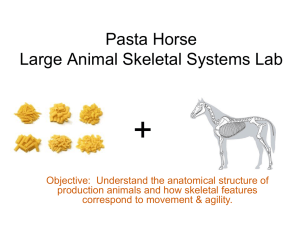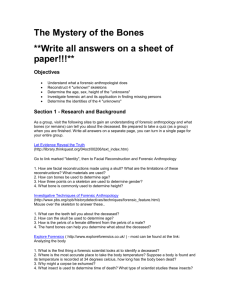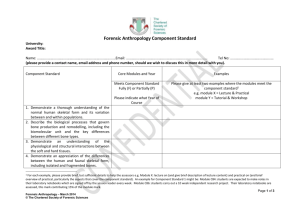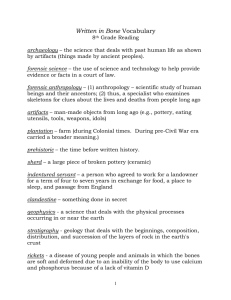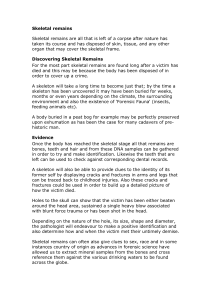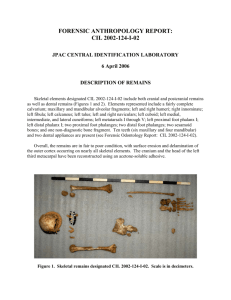ANTH_250-001 Brenda Clark
advertisement
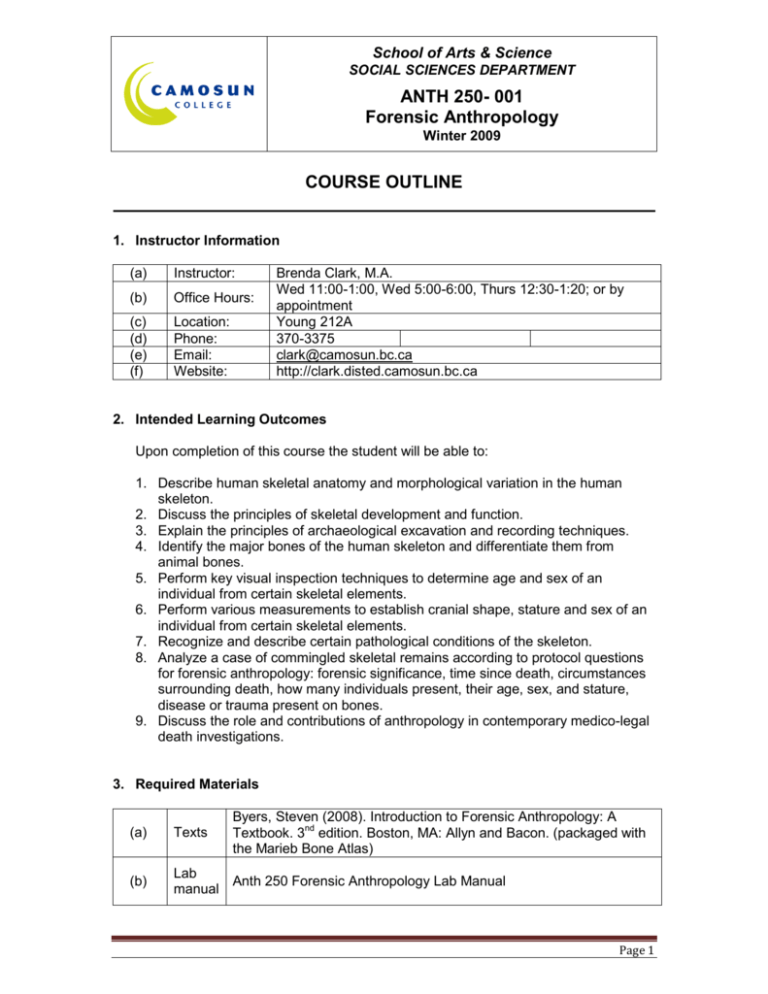
School of Arts & Science SOCIAL SCIENCES DEPARTMENT ANTH 250- 001 Forensic Anthropology Winter 2009 COURSE OUTLINE 1. Instructor Information (a) Instructor: (b) Office Hours: (c) (d) (e) (f) Location: Phone: Email: Website: Brenda Clark, M.A. Wed 11:00-1:00, Wed 5:00-6:00, Thurs 12:30-1:20; or by appointment Young 212A 370-3375 clark@camosun.bc.ca http://clark.disted.camosun.bc.ca 2. Intended Learning Outcomes Upon completion of this course the student will be able to: 1. Describe human skeletal anatomy and morphological variation in the human skeleton. 2. Discuss the principles of skeletal development and function. 3. Explain the principles of archaeological excavation and recording techniques. 4. Identify the major bones of the human skeleton and differentiate them from animal bones. 5. Perform key visual inspection techniques to determine age and sex of an individual from certain skeletal elements. 6. Perform various measurements to establish cranial shape, stature and sex of an individual from certain skeletal elements. 7. Recognize and describe certain pathological conditions of the skeleton. 8. Analyze a case of commingled skeletal remains according to protocol questions for forensic anthropology: forensic significance, time since death, circumstances surrounding death, how many individuals present, their age, sex, and stature, disease or trauma present on bones. 9. Discuss the role and contributions of anthropology in contemporary medico-legal death investigations. 3. Required Materials Byers, Steven (2008). Introduction to Forensic Anthropology: A Textbook. 3nd edition. Boston, MA: Allyn and Bacon. (packaged with the Marieb Bone Atlas) (a) Texts (b) Lab Anth 250 Forensic Anthropology Lab Manual manual Page 1 4. Basis of Student Assessment (Weighting) (a) Assignments Lab assignments are worth 10% of the final grade. Quizzes 40% (b) Exams (c) Case Report 25% (d) There are 3 lecture quizzes equally weighted. See the course sequence for dates. Lecture exams cover only material that is dealt with in lectures and your textbook. These will be 40 minute quizzes followed by the lecture. Lab Exam: 25%. The lab exam covers basic skeletal identification as well as some skills-based questions on sex determination. The lab exam is a bell-ringer exam, which means that there will be stations located throughout the lab and you will spend a limited amount of time at each station in order to answer the questions. Bell-ringer responses are brief and do not require extensive written answers. The case report involves analysis of human skeletal remains in a team context and writing a report discussing the evidence and your conclusions. You will have two lab periods in which to analyze the bones. NOTE: all team members must be present for both lab periods. Do not arrange travel, job interviews, etc for those dates! The case report acts as your final exam. The formal report, type written, is due on or before noon Tuesday April 14th. All exams and the case report must be attempted and an overall passing grade achieved in order to pass this course. Exams must be written at the scheduled times unless prior notice has been given to the instructor and approval received to write at a different time. If a student misses an exam due to illness, s/he must present a medical note to write a makeup exam. There will be no exceptions. 5. Grading System Standard Grading System (GPA) Percentage Grade 90-100 85-89 80-84 77-79 73-76 70-72 65-69 60-64 A+ A AB+ B BC+ C 50-59 D 0-49 F Description Minimum level of achievement for which credit is granted; a course with a "D" grade cannot be used as a prerequisite. Minimum level has not been achieved. Grade Point Equivalency 9 8 7 6 5 4 3 2 1 0 Page 2 Temporary Grades Temporary grades are assigned for specific circumstances and will convert to a final grade according to the grading scheme being used in the course. See Grading Policy at camosun.ca or information on conversion to final grades, and for additional information on student record and transcript notations. Temporary Grade I IP CW Description Incomplete: A temporary grade assigned when the requirements of a course have not yet been completed due to hardship or extenuating circumstances, such as illness or death in the family. In progress: A temporary grade assigned for courses that are designed to have an anticipated enrollment that extends beyond one term. No more than two IP grades will be assigned for the same course. Compulsory Withdrawal: A temporary grade assigned by a Dean when an instructor, after documenting the prescriptive strategies applied and consulting with peers, deems that a student is unsafe to self or others and must be removed from the lab, practicum, worksite, or field placement. 6. Recommended Materials or Services to Assist Students to Succeed Throughout the Course LEARNING SUPPORT AND SERVICES FOR STUDENTS There are a variety of services available for students to assist them throughout their learning. This information is available in the College calendar, at Student Services or the College web site at camosun.ca. STUDENT CONDUCT POLICY There is a Student Conduct Policy which includes plagiarism. It is the student’s responsibility to become familiar with the content of this policy. The policy is available in each School Administration Office, at Student Services and on the College web site in the Policy Section. Page 3 7. Course Content and Schedule WEEK 1 Jan 5-9 2 Jan 12-16 LAB Registration and Course Outline Introduction to the Human Skeleton Lab 1 Appendicular Skeleton Read Ch. 2 of Byers for an overview of skeletal anatomy 3 Jan 19-23 LECTURE Introduction to Forensic Anthropology Readings: Chapters 1 and 3 Structure and Function of the Human Skeleton Readings: Chapter 2: Basic Topics in Osteology pp 52-58 Lab 2 Stature Estimation and Sex Determination from the Femur Shoulder Girdle and Thorax Lab 3 Pelvic Girdle Sex determination using the os coxae (Ch. 8 pp177-182) Changes After Death and Post Mortem Interval Readings: Chapter 5 Lab 4 Cranial Skeleton and Sex Determination from the Skull (Ch. 8 pp184-190) The Role of the Coroner in British Columbia: guest lecture from Regional Coroner’s Office REVIEW LAB CSI Victoria: guest lecture from Victoria City Police Forensic Identification Section 7 Feb 16-20 BELLRINGER EXAM READING BREAK 8 Feb 23-27 Lab 5 Cranial Measurements and Ancestry Forensic Archaeology Readings: Chapter 4 9 Mar 2-6 Lab 6 Antemortem Conditions The Human Skeleton: growth and development. Readings: Chapter 9 10 Mar 9-13 Lab 7 Estimating Age at Death: Developmental Aging Lecture Quiz #2 Antemortem Conditions Readings: Chapters 11 and 15 11 Mar 1620 Lab 8 Estimating Age at Death: Senescent Aging Post Mortem Changes to Bone Readings Chapter 16 12 Mar 2327 Lab 9 Estimating Minimum Number of Individuals Establishing Identity Film: Following Antigone Readings: Chapters 17, 18, 19 13 Mar 31 April 3 14 April 610 Open Lab: Case Work Lecture Quiz #3 Case report writing Students do case report writing 4 Jan 26-30 5 Feb 2-6 6 Feb 9-13 Lecture Quiz #1 Film: Body Detectives Ch. 7pp152-164 Open Lab: Case Work Page 4
